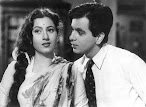काही अभिनेते–अभिनेत्रींची एक ठरलेली प्रतिमा आपल्या मनात इतकी घट्ट बसलेली असते, की त्यांचे नाव ऐकताच तोच प्रकार डोळ्यांसमोर उभा राहतो. उदा. अजित म्हटलं की “मोना डार्लिंग” म्हणणारा खलनायक आठवतो; मेहमूद म्हटलं की विनोदवीराचीच प्रतिमा दिसते. निरूपा रॉय यांच्या बाबतीतही हेच झालं आहे. त्यांचे नाव घेताच चित्रपटातील गरीब, असहाय्य आईचीच प्रतिमा उभी राहते. पण जर मी तुम्हाला सांगितलं की हीच निरूपा रॉय एकेकाळी हिंदी चित्रपटांची नायिका होती, तर तुमचा विश्वास बसणार नाही. पण हे पूर्णपणे खरं आहे. एवढंच काय—आपल्या (म्हणजे मराठी) जयश्री गडकर यांनीही सुरुवातीच्या काळात काही हिंदी चित्रपटांमध्ये नायिकेच्या भूमिका केल्या आहेत!
 |
| Photo courtesy The Hindu |
आजचे गाणे खरं तर मुळातून मीरेचे एक प्रसिद्ध भजन आहे. पण चित्रपटासाठी त्यातील फक्त काही ओळी घेऊन मजरुह सुलतानपुरी यांनी प्रसंगाला अनुरूप असे सुंदर गीत तयार केले आहे.
या गीताला अप्रतिम असं संगीत दिलं आहे पं. अमरनाथ यांनी. पंडितजी स्वतः एक उत्तम शास्त्रीय गायक होते. "गरम कोट" हा त्यांनी संगीत दिलेला पहिला आणि शेवटचा हिंदी चित्रपट. त्यांच्याबद्दल अधिक माहिती http://panditamarnath.in/ या वेबसाईटवर मिळेल. तेथील माहितीनुसार लता मंगेशकर यांना आज सादर करत असलेले गाणे इतके आवडले की त्यांनी आपल्या आवडत्या दहा गाण्यांच्या यादीत त्याचा समावेश केला होता!
मीरेच्या भजनातील मूळ ओळी अशा आहेत:
तर मजरुह यांनी लिहिलंय:
हे गाणे चित्रपटात दोन भागांत येते—पहिल्या भागात गीता कामावर जाणाऱ्या गिरधारीला प्रेमाने निरोप देताना, आणि दुसऱ्या भागात गिरधारीला परत यायला विलंब झाल्यामुळे गीता काळजीने त्याची वाट पाहताना.
पहिल्या भागात लताजी फक्त मुखडा गातात आणि तोही पार्श्वसंगीताशिवाय. त्यामुळे त्यांचा गोड, कोमल आवाज ऐकायला मिळतो. येथे गीता पतीला आनंदाने निरोप देत असल्याने मुखड्याचा भावही प्रेमळ आहे. गिरधारीही खुश होऊन घराबाहेर पडताना तोच मुखडा गुणगुणत निघतो—बहुधा बलराज साहनी यांनी स्वतःच म्हटला असावा.
दुसऱ्या भागात मात्र संपूर्ण गीत आहे. गिरधारी उशिरा येत असल्यामुळे गीतेला जाणवणारी काळजी, वेदना आणि हुरहूर लताजींच्या आवाजातून स्पष्टपणे अनुभूतीस येते. दोन्ही भागांतील मुखड्यांचे गायन भावानुसार वेगळे भासते
दुसरा भाग सुरू होताच रात्री आठचे ठोके पडतात आणि व्याकुळ झालेली गीता म्हणते, “प्रीत किए दुख होय.” लताजींचा हळवा, काळीज पिळवटून टाकणारा आवाज क्षणात मन व्यापून टाकतो. “प्रीत किए” मधील “किए” आणि “होय” वरील स्वरांचा ठहराव तर अद्वितीय आहे. “जोगिया मीत ना कोई” मधील “जोगिया” चा उच्चार लाजवाब—लताजींच्याच गळ्यातून उतरू शकणारा. “रैन दिवस कल नाहीं परत है” ही ओळ तीनवेळा आली असली तरी प्रत्येकवेळी लहानसा फरक आहे; आणि तो समजला, तर गाण्याची रंगत आणखी खुलते. “कब रे मिलोगे” मधील आर्तता थेट हृदयाला भिडते.
संपूर्ण गाण्यात वाजणारी सारंगी गाण्याच्या करुणतेत भर घालते. फक्त सारंगी आणि तबल्यावर अशी अप्रतिम रचना बांधणाऱ्या संगीतकाराचे कौतुक करावे तितके थोडे.
हे गाणे तुम्हालादेखील नक्कीच आवडेल, अशी आशा आहे. धन्यवाद.
Some actors and actresses acquire such a fixed image in our minds that the moment we hear their names, one particular kind of character immediately appears before our eyes. For instance, when we think of Ajit, we recall the villain who says “Mona Darling”; when we think of Mehmood, the image of a comedian comes to mind. The same has happened with Nirupa Roy. Her name instantly brings to mind the image of the poor, helpless mother from Hindi cinema. But if I were to tell you that this very Nirupa Roy was once a leading lady in Hindi films, you might find it hard to believe. Yet it is absolutely true. In fact, even our own (Marathi) Jayshree Gadkar had played the heroine in a few Hindi films during the early part of her career!
 |
| Photo Courtesy The Hindu |
This song is originally based on a famous bhajan by Meerabai. For the film, lyricist Majrooh Sultanpuri adapted only a few lines from the original and created a beautiful song suited to the situation.
The music for this song was composed by Pandit Amarnath, who himself was an excellent classical vocalist. Garam Coat was both his first and last Hindi film as a composer. More information about him can be found on the website named after him. According to the information there, Lata Mangeshkar loved this song so much that she included it among her ten personal favourites.
The original lines from Meerabai’s bhajan are:
And the lines written by Majrooh for the film are:
The song appears in two parts in the film—first when Geeta lovingly sends Girdhari off to work, and the second when she anxiously waits for him late into the night after he gets delayed returning home.
In the first part, Lataji sings only the opening verse, and that too without any background music, allowing her naturally sweet voice to shine. Here, the emotion is tender, as Geeta happily bids farewell to her husband. Girdhari, pleased, steps out of the house humming the same lines—likely sung by Balraj Sahni himself.
The second part contains the full song. Since Girdhari is late, Geeta’s worry, sorrow, and longing are vividly brought out through Lataji’s voice. The rendering of the opening lines differs in both parts, perfectly aligned with the changing emotions.
As the second part begins, the clock strikes eight, and the anxious Geeta sings, “Preet kiye dukh hoye.” Lataji’s soft, heart-piercing voice captures us instantly. The delicate pauses on the words “kiye” and “hoye” are exquisite. The way she sings “jogiya” in “jogiya meet na koi” is simply unmatched—something only Lata could deliver. She sings the line “rain divas kal nahin parat hai” three times, each with a subtle variation that enriches the expression. And the yearning in “kab re miloge” touches the heart deeply.
The sarangi, played throughout the song, beautifully enhances its pathos. The composer has built this exceptional piece using only sarangi and tabla—a feat that deserves immense appreciation.
I hope you will enjoy this song just as much. Thank you.







































